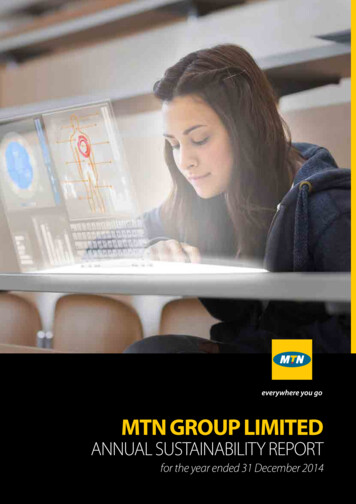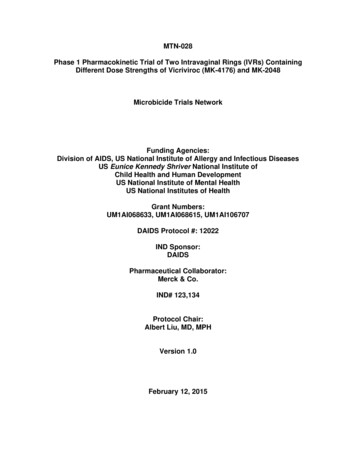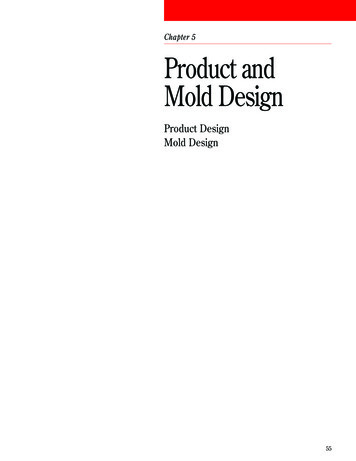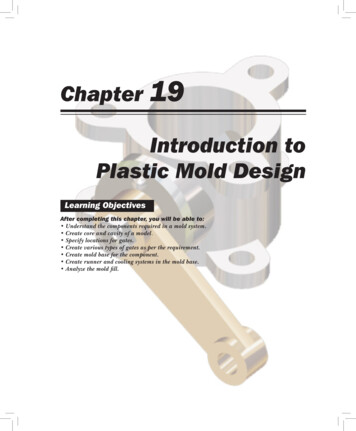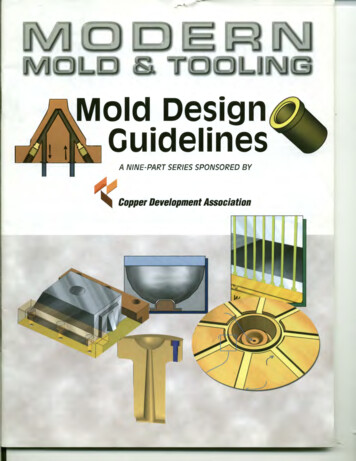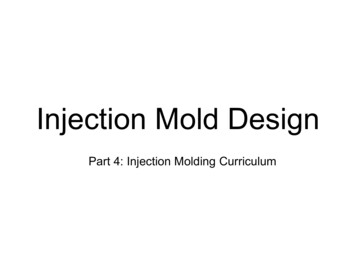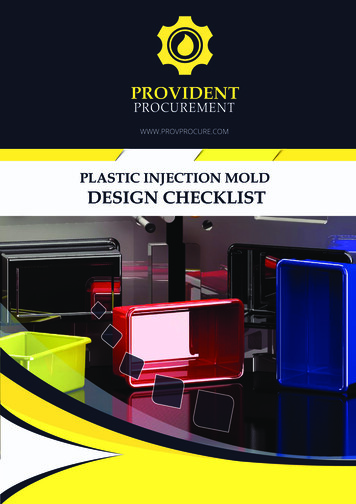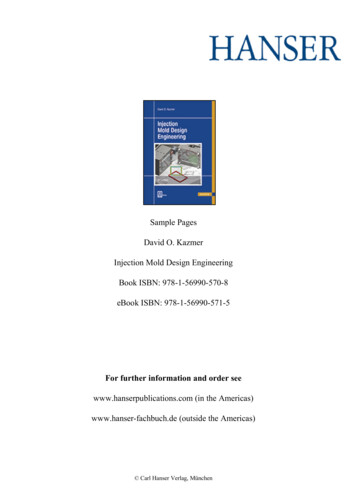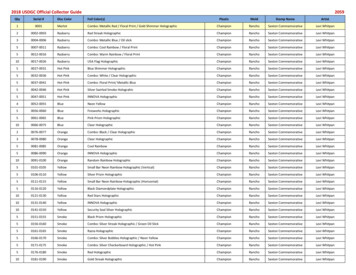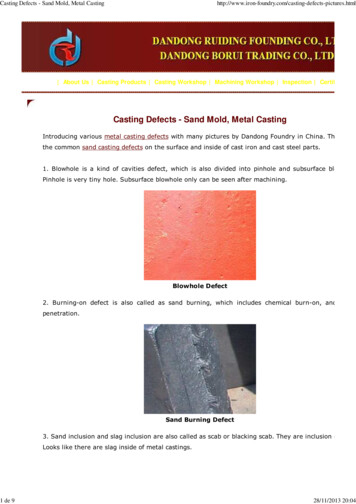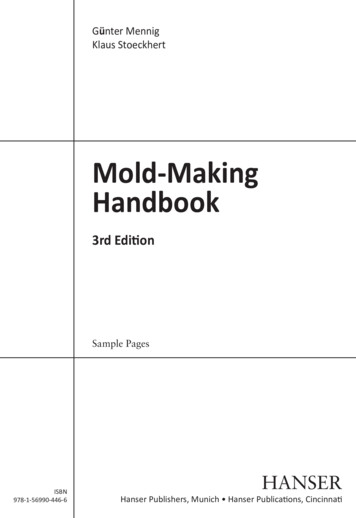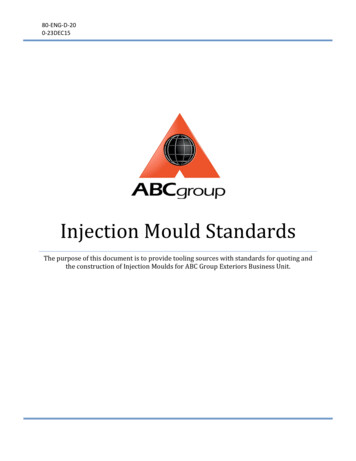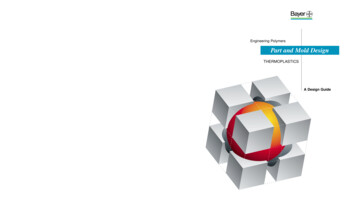
Transcription
Bayer CorporationBayer Corporation 100 Bayer Road Pittsburgh, PA 15205-9741 es Offices:California:9 Corporate Park Drive, Suite 240, Irvine, CA 92506-51131-949-833-2351 Fax: 1-949-752-1306Michigan:Engineering Polymers2401 Walton Boulevard, Auburn Hills, MI 48325-19571-248-475-7700 Fax: 1-248-475-7701New Jersey:Part and Mold Design1000 Route 9 North, Suite 103, Woodbridge, NJ 07095-12001-732-726-8988 Fax: 1-732-726-1672Illinois:9801 W. Higgins Road, Suite 420, Rosemont, IL 60018-4704Canadian Affiliate:Ontario:Bayer Inc.77 Belfield Road, Etobicoke, Ontario M9W 1G61-416-248-0771 Fax: 1-416-248-6762Quebec:Bayer Inc.7600 Trans Canada Highway, Pointe Claire, Quebec H9R 1C81-514-697-5550 Fax: 1-514-697-5334The information contained in this bulletin is current as of April 2000.Please contact Bayer Corporation to determine whether thispublication has been revised.Printed on recycled paperKU-GE028Copyright 2000, Bayer CorporationPrinted in U.S.A.570 (25M) 04/00THERMOPLASTICSNote:Part and Mold Design1-847-692-5560 Fax: 1-847-692-7408THERMOPLASTICSA Design Guide
INTRODUCTIONA product of the Bayer DesignEngineering Services Group, this manualis primarily intended as a referencesource for part designers and moldingengineers working with Bayer thermoplastic resins. The table of contents andindex were carefully constructed toguide you quickly to the informationyou need either by topic or by keyword.The content was also organized to allowthe manual to function as an educationaltext for anyone just entering the field ofplastic-part manufacturing. Conceptsand terminology are introduced progressively for logical cover-to-coverreading.The manual focuses primarily onplastic part and mold design, but alsoincludes chapters on the design process;designing for assembly; machining andfinishing; and painting, plating, anddecorating. For the most part, it excludesinformation covered in the followingBayer companion publications:Contact your Bayer sales representativefor copies of these publications.Material Selection: Thermoplastics andPolyurethanes: A comprehensive look atmaterial testing and the issues to considerwhen selecting a plastic material. Makrolon PolycarbonateJoining Techniques: Includes information and guidelines on the methodsfor joining plastics including mechanicalfasteners, welding techniques, inserts,snap fits, and solvent and adhesivebonding.This publication was written specificallyto assist our customers in the design andmanufacture of products made from theBayer line of thermoplastic engineeringresins. These resins include: Apec High-Heat Polycarbonate Bayblend Polycarbonate/ABS Blend Makroblend Polycarbonate Blend Triax Polyamide/ABS Blend Lustran and Novodur ABSSnap-Fit Joints for Plastics: Containsthe engineering formulas and workedexamples showing how to design snapfit joints for Bayer thermoplastic resins. Lustran SAN Cadon SMA Centrex ASA, AES and ASA/AESWeatherable Polymers Durethan Polyamide 6 and 66,and Amorphous Polyamide Texin and Desmopan Thermoplastic Polyurethane Pocan PBT Polyester1
Most of the design principles covered inthis manual apply to all of these resins.When discussing guidelines or issuesfor a specific resin family, we referencethese materials either by their Bayertrade names or by their genericpolymer type.The material data scattered throughoutthe chapters is included by way ofexample only and may not reflect themost current testing. In addition, muchof the data is generic and may differfrom the properties of specific resingrades. For up-to-date performance datafor specific Bayer resins, contact yourBayer sales representative or refer to thefollowing information sources:Bayer Engineering Polymers PropertiesGuide: Contains common single-pointproperties by resin family and grade.Bayer Plastics Product InformationBulletin: Lists information and propertiesfor a specific material grade.2Bayer CAMPUS: Software containingsingle and multi-point data that wasgenerated according to uniform standards.Allows you to search grades of Bayerresins that meet a particular set ofperformance requirements.www.bayer.com/polymers-usa: BayerWeb site containing product informationon-line.This manual provides general informationand guidelines. Because each productapplication is different, always conducta thorough engineering analysis of yourdesign, and prototype test new designsunder actual in-use conditions. Applyappropriate safety factors, especiallyin applications in which failure couldcause harm or injury.In addition to design manuals, BayerCorporation provides design assistancein other forms such as seminars andtechnical publications. Bayer also offersa range of design engineering servicesto its qualified customers. Contact yourBayer sales representative for moreinformation on these other services.
TABLE OF CONTENTSChapter 1PART DESIGN PROCESS: CONCEPT TO FINISHED PARTChapter 2GENERAL DESIGN7Design Process19Wall Thickness8Defining Plastic Part Requirements22Flow Leaders and RestrictorsRibs8Mechanical Loading248Temperature248Chemical Exposure24Rib Thickness8Electrical Performance26Rib Size8Weather 9Agency Approvals30Sharp Corners9Life Expectancy32Draft9Dimensional Tolerances33Holes and Cores9Processing34Undercuts9Production Quantities349Cost Constraints36Louvers and Vents10Assembly37Molded-In Threads10Rib Location and NumbersSlides and Cores40Lettering10Injection Molding40Tolerances11Extrusion42Bearings and Gears12Thermoforming12Blow Molding13Rotomolding13Thermoplastic Processing MethodsRib DesignOptimizing Product s and Logos1515MiscellaneousReducing Manufacturing Costs15Materials16Overhead17Labor1717Scrap and ReworkPrototype Testing3
Chapter 3STRUCTURAL DESIGNChapter 4DESIGN FOR ASSEMBLY4583Part Consolidation46Stiffness84Mechanical Fasteners46Viscoelasticity85Snap-Fit Joints48Stress-Strain Behavior88Welding and Bonding50Molding Factors89Ultrasonic Welding90Vibration and Hot-Plate Welding51Structural Considerations In PlasticsShort-Term Mechanical Properties51Tensile Properties91Spin Welding52Tensile Modulus91Solvent and Adhesive Bonding52Tensile Stress at Yield92Retention Features52Tensile Stress at Break92Alignment Features53Ultimate Strength94Orientation53Poisson's Ratio94Expansion Differences53Compressive Properties94Tolerances53Flexural Modulus5354Coefficient of FrictionLong-Term Mechanical PropertiesChapter 5MACHINING AND FINISHING54Creep Properties56Stress Relaxation97Drilling and Reaming56Fatigue Properties99Tapping58Structural Design Formulas99Sawing58Use of Moduli100 Punching, Blanking, and Die Cutting59Stress and Strain Limits101 Milling60Uniaxial Tensile and Compressive Stress101 Turning and Boring61Bending and Flexural Stress102 Laser Machining65Shear Stress103 Filing66Torsion103 Sanding67Designing for Stiffness67Part Shape70Wall Thickness71Ribs73Long-Term Loading76Designing for Impact78Fatigue Applications80Thermal Loading4103 Polishing and Buffing104 Trimming, Finishing, and Flash Removal
Chapter 6PAINTING, PLATING, AND DECORATINGChapter 7MOLD DESIGN105 Painting121 Mold Basics105Types of Paints121 Types of Molds106Paint Curing124 Mold Bases and Cavities106Paint-Selection Considerations125 Molding Undercuts107Spray Painting128 Part Ejection108Other Painting Methods130 Mold Venting108Masking130Parting-Line Vents109Other Design Considerations for Painting131Vent Placement109 In-Mold Decorating133 Sprues, Runners, and Gates110 Film-Insert Molding133Sprues111 Metallic Coatings134Runners111137Runners for Multicavity Molds112Design Considerations for Electroplating140Gates113Molding Considerations for Electroplating144Other Gate Designs145Gate Optimization147Gate Position114ElectroplatingVacuum Metallization115115Design Considerations for Vacuum MetallizationEMI/RFI Shielding115Design Considerations for EMI/RFI Shielding149 Hot-Runner Systems149Hot-Runner Designs116 Printing149Hot-Runner Gates118 Labels and Decals151Valve Gates119 Texture151 Thermal Expansion and Isolation152Flow Channel Size153 Mold Cooling154Mold-Cooling Considerations155Cooling-Channel Placement158Cooling-Line Configuration159Coolant Flow Rate160 Mold Shrinkage162 Mold Metals163 Surface Treatments164 Mold Cost and QualityAPPENDICES165 Index169 Part Design Checklist5
6
Chapter 1PART DESIGN PROCESS:CONCEPT TO FINISHED PARTMany factors affect plastic-part design.Among these factors are: functionalrequirements, such as mechanicalloading and ultraviolet stability;aesthetic needs, such as color, level oftransparency, and tactile response; andeconomic concerns, such as cost ofmaterials, labor, and capital equipment.These factors, coupled with otherdesign concerns — such as agencyapproval, processing parameters,and part consolidation — are discussedin this chapter.DESIGN PROCESSLike a successful play in football,successful plastic product design andproduction requires team effort and awell-developed strategy. When designingplastic parts, your team should consistof diverse players, including conceptualdesigners, stylists, design engineers,materials suppliers, mold makers,manufacturing personnel, processors,finishers, and decorators. Your chanceof producing a product that successfullycompetes in the marketplace increaseswhen your strategy takes full advantageof team strengths, accounts for members’limitations, and avoids overburdeningany one person. As the designer, youmust consider these factors early instrategy development and makeadjustments based upon input from thevarious people on the design team.Solicit simultaneous input from the various “players” early in product development, before many aspects of the designhave been determined and cannot bechanged. Accommodate suggestions forenhancing product performance, or forsimplifying and improving the variousmanufacturing steps such as moldconstruction, processing, assembly,and finishing. Too often designs passsequentially from concept developmentto manufacturing steps with featuresthat needlessly complicate productionand add cost.Early input from various design andmanufacturing groups also helps tofocus attention on total product costrather than just the costs of individualitems or processes. Often adding aprocessing step and related cost in onearea produces a greater reduction intotal product cost. For example, addingsnap latches and nesting features mayincrease part and mold costs, and at thesame time, produce greater savings inassembly operations and related costs.Likewise, specifying a more-expensiveresin with molded-in color and UVresistance may increase your rawmaterial cost, while eliminatingpainting costs.When designing and developing parts,focus on defining and maximizing partfunction and appearance, specifyingactual part requirements, evaluatingprocess options, selecting an appropriate material, reducing manufacturingcosts, and conducting prototype testing.For the reasons stated above, theseefforts should proceed simultaneously.7
DEFINING PLASTIC PARTREQUIREMENTSThoroughly ascertain and evaluate yourpart and material requirements, whichwill influence both part design andmaterial selection. When evaluatingthese requirements, consider more thanjust the intended, end-use conditionsand loads: Plastic parts are often subjected to harsher conditions duringmanufacturing and shipping than inactual use. Look at all aspects of partand material performance includingthe following.Mechanical LoadingCarefully evaluate all types of mechanicalloading including short-term staticloads, impacts, and vibrational orcyclic loads that could lead to fatigue.Ascertain long-term loads that couldcause creep or stress relaxation. Clearlyidentify impact requirements.TemperatureMany material properties in plastics —impact strength, modulus, tensilestrength, and creep resistance to name afew — vary with temperature. Considerthe full range of end-use temperatures,as well as temperatures to which the partwill be exposed during manufacturing,finishing, and shipping. Remember thatimpact resistance generally diminishesat lower temperatures.8Chemical ExposurePlastic parts encounter a wide variety ofchemicals both during manufacturingand in the end-use environment,including mold releases, cutting oils,degreasers, lubricants, cleaning solvents, printing dyes, paints, adhesives,cooking greases, and automotive fluids.Make sure that these chemicals arecompatible with your selected materialand final part.Electrical PerformanceNote required electrical property valuesand nature of electrical loading. Forreference, list materials that are knownto have sufficient electrical performancein your application. Determine ifyour part requires EMI shielding orUL testing.Weather ResistanceTemperature, moisture, and UV sunexposure affect plastic parts’ propertiesand appearance. The end-use of a productdetermines the type of weather resistancerequired. For instance, external automotive parts such as mirror housings mustwithstand continuous outdoor exposureand perform in the full range of weatherconditions. Additionally, heat gain fromsun on dark surfaces may raise the uppertemperature requirement considerablyhigher than maximum expected temperatures. Conversely, your requirementsmay be less severe if your part isexposed to weather elements onlyoccasionally. For example, outdoorChristmas decorations and other seasonal products may only have to satisfy therequirements for their specific, limitedexposure.RadiationA variety of artificial sources — suchas fluorescent lights, high-intensity discharge lamps, and gamma sterilizationunits — emit radiation that can yellowand/or degrade many plastics. If yourpart will be exposed to a radiationsource, consider painting it, or specifyinga UV-stabilized resin.AppearanceAesthetic requirements can entail manymaterial and part-design issues. Forexample, a need for transparency greatlyreduces the num
MOLD DESIGN 121 Mold Basics 121 Types of Molds 124 Mold Bases and Cavities 125 Molding Undercuts 128 Part Ejection 130 Mold Venting 130 Parting-Line Vents 131 Vent Placement 133 Sprues, Runners, and Gates 133 Sprues 134 Runners 137 Runners for Multicavity Molds 140 Gates 144 Other Gate Designs 145 Gate Optimization 147 Gate Position 149 Hot-Runner Systems 149 Hot-Runner File Size: 2MBPage Count: 174
